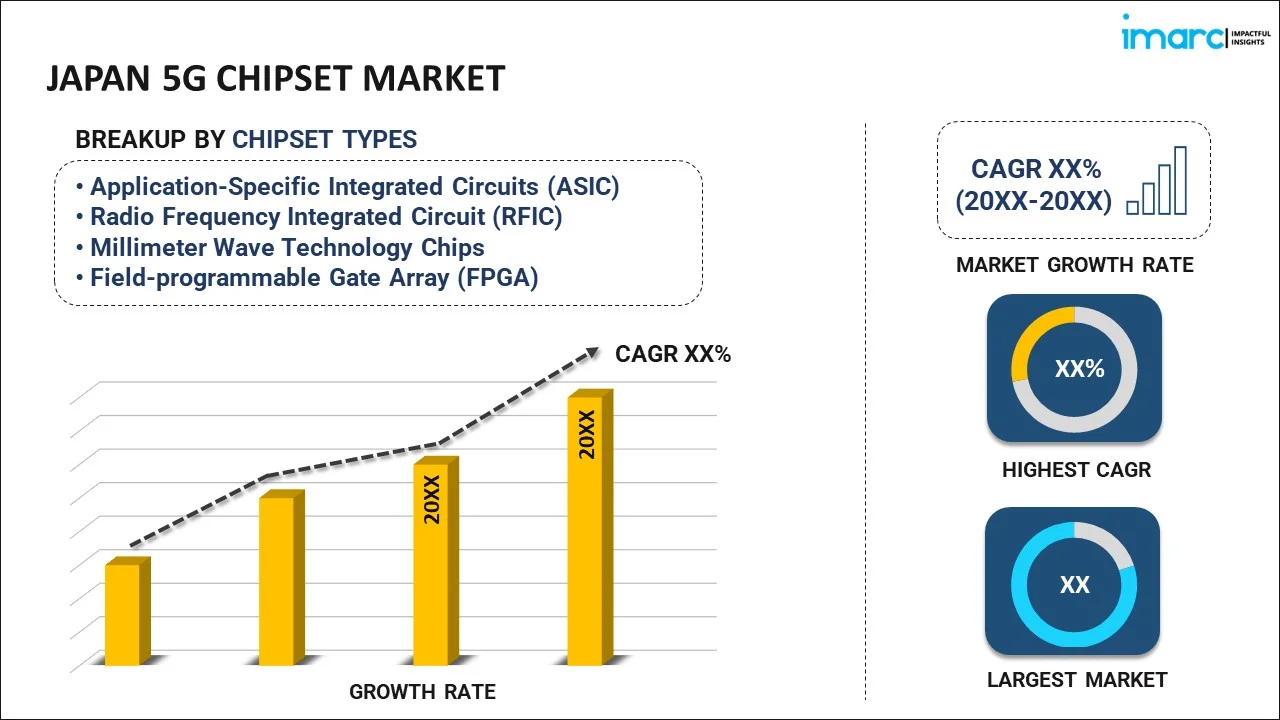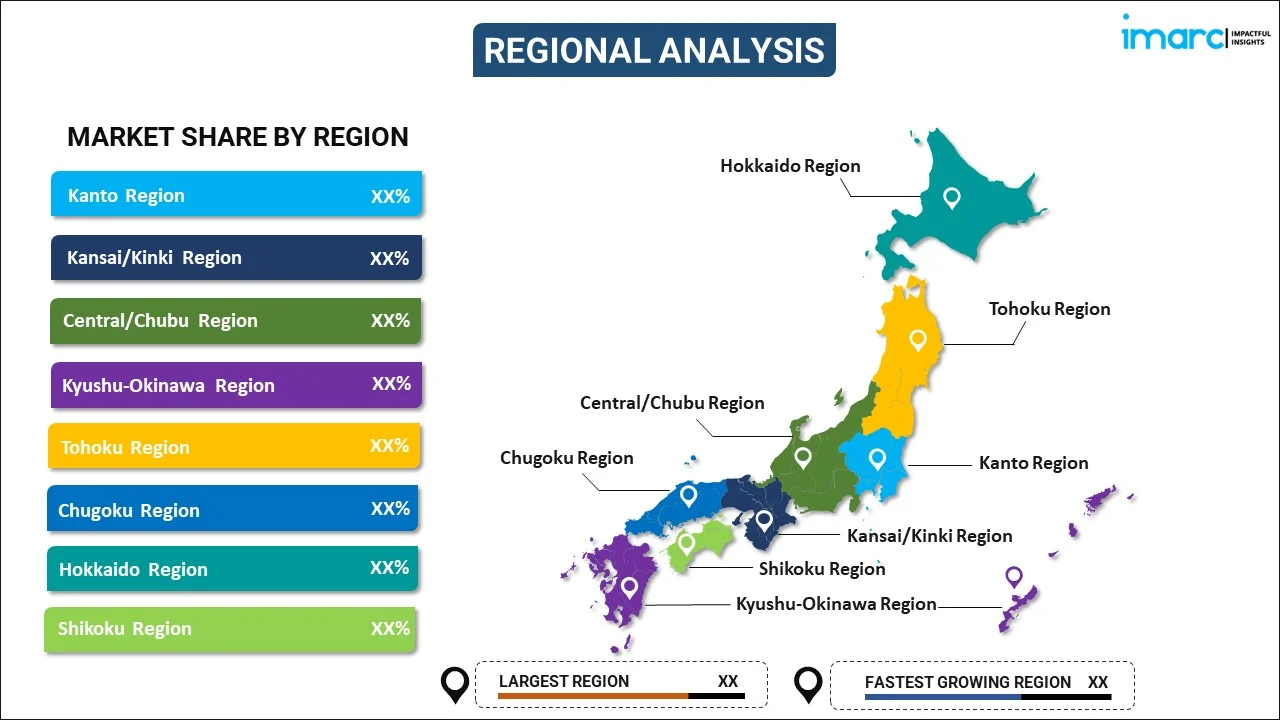
Japan 5G Chipset Market Report by Chipset Type (Application-Specific Integrated Circuits (ASIC), Radio Frequency Integrated Circuit (RFIC), Millimeter Wave Technology Chips, Field-programmable Gate Array (FPGA)), Operational Frequency (Sub 6 GHz, Between 26 and 39 Ghz, Above 39 Ghz), End User (Consumer Electronics, Industrial Automation, Automotive and Transportation, Energy and Utilities, Healthcare, Retail, and Others), and Region 2025-2033
Market Overview:
Japan 5G chipset market size reached USD 513.5 Million in 2024. Looking forward, IMARC Group expects the market to reach USD 4,508.1 Million by 2033, exhibiting a growth rate (CAGR) of 24.6% during 2025-2033. The ongoing advancement of 5G chipsets is propelling the transformation of mobile devices, IoT applications, and various industries relying on swift and low-latency connectivity, which in turn, is primarily driving the market growth.
|
Report Attribute
|
Key Statistics
|
|---|---|
|
Base Year
|
2024 |
|
Forecast Years
|
2025-2033
|
|
Historical Years
|
2019-2024
|
| Market Size in 2024 | USD 513.5 Million |
| Market Forecast in 2033 | USD 4,508.1 Million |
| Market Growth Rate (2025-2033) | 24.6% |
A 5G chipset is a dedicated integrated circuit crafted to facilitate communication and data handling for devices that utilize 5G cellular technology. It consolidates a range of elements like modems, processors, and radio frequency components, with the primary purpose of enabling rapid wireless connections within the 5G network. These chipsets play a pivotal role in elevating data transfer speeds, minimizing delays, and supporting advanced functionalities such as connectivity for the Internet of Things (IoT) and immersive media streaming.
Japan 5G Chipset Market Trends:
The Japan 5G chipset market has emerged as a dynamic and pivotal sector within the country's technological landscape, reflecting its commitment to innovation and its aspiration to lead in the realm of connectivity. Japan has been at the forefront of 5G technology development, and its chipset market is a critical component of this advancement. The market is characterized by a robust ecosystem of semiconductor companies and manufacturers, with a strong focus on research and development. One of the driving forces behind Japan's booming 5G chipset market is the nation's ambitious goals for technological leadership. Apart from this, Japan recognizes the transformative potential of 5G technology, not just for faster mobile communication but also for enabling breakthroughs in various sectors such as healthcare, autonomous vehicles, smart cities, and the Internet of Things (IoT). Moreover, Japan's reputation for producing high-quality electronics and its stringent quality standards have positioned it as a trusted supplier of 5G chipsets, both domestically and globally. Besides this, Japanese semiconductor companies are known for their expertise in designing and manufacturing reliable, high-performance chipsets, which makes them preferred partners for international collaborations and exports. In addition to domestic demand, Japan's 5G chipset manufacturers are actively exploring opportunities in the regional market, leveraging their technological prowess and track record to establish a strong presence on the international stage. As 5G continues to evolve and expand its footprint, Japan's chipset market is poised for sustained growth and innovation, over the forecasted period.
Japan 5G Chipset Market Segmentation:
IMARC Group provides an analysis of the key trends in each segment of the market, along with forecasts at the country level for 2025-2033. Our report has categorized the market based on chipset type, operational frequency, and end user.
Chipset Type Insights:

- Application-Specific Integrated Circuits (ASIC)
- Radio Frequency Integrated Circuit (RFIC)
- Millimeter Wave Technology Chips
- Field-programmable Gate Array (FPGA)
The report has provided a detailed breakup and analysis of the market based on the chipset type. This includes application-specific integrated circuits (ASIC), radio frequency integrated circuit (RFIC), millimeter wave technology chips, and field-programmable gate array (FPGA).
Operational Frequency Insights:
- Sub 6 GHz
- Between 26 and 39 Ghz
- Above 39 Ghz
A detailed breakup and analysis of the market based on the operational frequency have also been provided in the report. This includes sub 6 GHz, between 26 and 39 Ghz, and above 39 Ghz.
End User Insights:
- Consumer Electronics
- Industrial Automation
- Automotive and Transportation
- Energy and Utilities
- Healthcare
- Retail
- Others
The report has provided a detailed breakup and analysis of the market based on the end user. This includes consumer electronics, industrial automation, automotive and transportation, energy and utilities, healthcare, retail, and others.
Regional Insights:

- Kanto Region
- Kansai/Kinki Region
- Central/ Chubu Region
- Kyushu-Okinawa Region
- Tohoku Region
- Chugoku Region
- Hokkaido Region
- Shikoku Region
The report has also provided a comprehensive analysis of all the major regional markets, which include Kanto Region, Kansai/Kinki Region, Central/ Chubu Region, Kyushu-Okinawa Region, Tohoku Region, Chugoku Region, Hokkaido Region, and Shikoku Region.
Competitive Landscape:
The market research report has also provided a comprehensive analysis of the competitive landscape in the market. Competitive analysis such as market structure, key player positioning, top winning strategies, competitive dashboard, and company evaluation quadrant has been covered in the report. Also, detailed profiles of all major companies have been provided.
Japan 5G Chipset Market Report Coverage:
| Report Features | Details |
|---|---|
| Base Year of the Analysis | 2024 |
| Historical Period | 2019-2024 |
| Forecast Period | 2025-2033 |
| Units | Million USD |
| Scope of the Report | Exploration of Historical Trends and Market Outlook, Industry Catalysts and Challenges, Segment-Wise Historical and Future Market Assessment:
|
| Chipset Types Covered | Application-Specific Integrated Circuits (ASIC), Radio Frequency Integrated Circuit (RFIC), Millimeter Wave Technology Chips, Field-programmable Gate Array (FPGA) |
| Operational Frequencies Covered | Sub 6 GHz, Between 26 and 39 Ghz, Above 39 Ghz |
| End Users Covered | Consumer Electronics, Industrial Automation, Automotive and Transportation, Energy and Utilities, Healthcare, Retail, Others |
| Regions Covered | Kanto Region, Kansai/Kinki Region, Central/ Chubu Region, Kyushu-Okinawa Region, Tohoku Region, Chugoku Region, Hokkaido Region, Shikoku Region |
| Customization Scope | 10% Free Customization |
| Post-Sale Analyst Support | 10-12 Weeks |
| Delivery Format | PDF and Excel through Email (We can also provide the editable version of the report in PPT/Word format on special request) |
Key Questions Answered in This Report:
- How has the Japan 5G chipset market performed so far and how will it perform in the coming years?
- What has been the impact of COVID-19 on the Japan 5G chipset market?
- What is the breakup of the Japan 5G chipset market on the basis of chipset type?
- What is the breakup of the Japan 5G chipset market on the basis of operational frequency?
- What is the breakup of the Japan 5G chipset market on the basis of end user?
- What are the various stages in the value chain of the Japan 5G chipset market?
- What are the key driving factors and challenges in the Japan 5G chipset?
- What is the structure of the Japan 5G chipset market and who are the key players?
- What is the degree of competition in the Japan 5G chipset market?
Key Benefits for Stakeholders:
- IMARC’s industry report offers a comprehensive quantitative analysis of various market segments, historical and current market trends, market forecasts, and dynamics of the Japan 5G chipset market from 2019-2033.
- The research report provides the latest information on the market drivers, challenges, and opportunities in the Japan 5G chipset market.
- Porter's five forces analysis assist stakeholders in assessing the impact of new entrants, competitive rivalry, supplier power, buyer power, and the threat of substitution. It helps stakeholders to analyze the level of competition within the Japan 5G chipset industry and its attractiveness.
- Competitive landscape allows stakeholders to understand their competitive environment and provides an insight into the current positions of key players in the market.
Need more help?
- Speak to our experienced analysts for insights on the current market scenarios.
- Include additional segments and countries to customize the report as per your requirement.
- Gain an unparalleled competitive advantage in your domain by understanding how to utilize the report and positively impacting your operations and revenue.
- For further assistance, please connect with our analysts.
 Inquire Before Buying
Inquire Before Buying
 Speak to an Analyst
Speak to an Analyst
 Request Brochure
Request Brochure
 Request Customization
Request Customization




.webp)




.webp)












